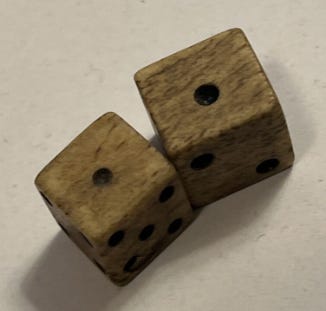Money and Gambling in 1874 France
History Notes for Chapter 9 - Sunny Above, Cloudy Below of Louisa Sophia and a Legion of Sisters
In the chapter, Sunny Above, Cloudy Below, Louisa discovers an injustice being done on the river barge the Last Chance Tour participants use to travel from Paris to the port of Le Harve. The three deck hands on the barge are playing a dice game, and one of the men is cheating.
Ethically challenged Louisa isn’t upset at the man’s transgression until she understands that one of the men cheated out of his money is intellectually disabled. Louisa might be a thief, but she has standards. She decides that she and the Clan of the Dissipated must right this wrong.
You might think to yourself; it doesn’t sound like there would be much history in such a black-and-white scene, but au contraire. For this simple Texan, there were two significant challenges. First, I needed to understand everything about French francs as they related to the scene.
What did they call a dime or a penny? A quick Google search educated me on the décime and the centime, but what were those worth in 1874? And how much did a barge worker make back then?
This information took a while longer to find, but I discovered some great information with the help of a useful resource hosted by the University of Missouri. They have links to US government reports that cover several hundred years. These scanned documents contain information on daily labor wages from many countries and for a plethora of occupations.
It took a little digging to find a French reference to an occupation related to barge workers. The closest I could find was an 1871 reference from France showing dock hands making the equivalent of $0.97 a day.
How many francs is that?
If you use the price of gold in francs and dollars in 1874, you can calculate a rate of 5.5 francs per dollar, but I just rounded that up to 6 francs per dollar.
Using all my gathered info and estimations, a barge worker in my book makes $30 a month or 180 French francs. To put that living wage into context, in 1871 Paris, a bottle of wine and a loaf of bread cost a 1/2 franc each while a kilo of top quality beef cost 2 francs.
Once I understood the value of the French franc, I moved on to the other hole in my knowledge. What gambling game did they play back then?
I’ve only been to Vegas a handful of times, and my favorite game is craps. Every time I think about gambling on the streets, I envision some guys squatting toadlike and tossing dice. In 1874, craps hadn’t quite come into its own, but its predecessor, Hazard, was well understood.
You can read the link to understand the game’s rules. If you do, I bet you’ll see the similarities and how Hazard inspired the modern game. After hours of research, my characters were finally ready to place realistic bets and for the scene to make sense.
Given the length of this article, you might have already realized that it took me as long to research as it did to write the chapter. And that is the plight and pleasure of the historical fiction author.




